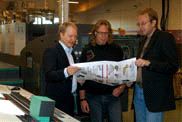Offset Printing
First Eight-Color ROLAND 500 up North

Wednesday 06. February 2008 - About the investment plan of a family-owned business
Three requirements the Swedish Linderoths Tryckeri wanted its new press to meet: it was to be highly productive, enable short delivery times – and of course the price should be right. Therefore the printers decided in favor of an eight-color ROLAND 500, the first in the North.
Linderoths Tryckeri in Vingåker, Sweden, is a true family-owned and family-operated business: the father, Lennart Wangenfors, is the CEO, and mother Inger in charge of finances. The two sons, Mats and Jonas, learned the trade from the bottom up and are now responsible for sales and production planning. Linderoths Tryckeri is the perfect example of a medium-size printing company preparing for the future by well-planned investment in machinery and infrastructure.
Tradition and expansion
Founded in 1898 as a bookstore, the company soon developed into a printing business in reaction to customer wishes. Over the past ten years, sales have kept growing steadily; two additional print shops were taken over in Katrineholm, a location of strategic importance. While formerly the company was strong in forms printing, today 23 employees at the sites operate in two shifts producing mainly commercial work for companies and institutions.
Productivity increased
Time saved in printing means greater flexibility. A decisive argument for Linderoths Tryckeri: with the eight-color ROLAND 500, longer runs can be printed, and considerably more orders accepted. This enables the printer to invest in new markets. With the ROLAND 500, Jonas Wangenfors answers a challenge many of his colleagues are facing: “Delivery dates are getting ever tighter. That makes it necessary to boost productivity and output. Today the jobs are done faster by the press, giving us more time for postpress work. Allowing paper thicknesses up to 0.6 millimeters, the press perfectly suits our flexible production.”
Color matching more exact
Exact color matching makes for faster job throughput. “Both ink and water balance are kept perfectly consistent by the press, independent of the printing speed,” Jonas and Mats Wangenfors agree. An important role is played by ink quality control, which measures the density during the printing process and the CIP3 files from prepress. “For this reason, the quality is better today, and more consistent as well,” says Mats Wangenfors. The new ROLAND 500 took the place of two older presses. Those machines required one hour to print 6,000 sheet in 4 + 0 colors. The new system does twice as many sheets per hour in 4 + 4. Makeready, too, is very much faster: a job that used to take two hours is now set up in half an hour.
CIP3 results in faster printing
Improved workflows optimize the efficiency. “We are highly satisfied with the CIP3 format, by which the printing of a job is so programmed in pre-press that all values are automatically set. That works like a charm and without any problem. The printing process is much faster even should one have to take corrective action,” explains Mats Wangenfors. In the near future, the company will switch to the successor format CIP4/JDF and integrate it into the GKS business system. In this way, the printer will achieve stringent information management – from customer contact of the sales representative to completion of the print product and through to billing. “This facilitates the daily work and leads to even more effective production,” Jonas Wangenfors expects for sure.
Fast installation
Installation of the eight-color ROLAND 500 was a fast and problem-free process. A strong team of technicians from Offenbach and from the local MAN Roland office assembled the machine, interruptions of production operations were minimized, and the press operators trained. The Linderoth printing company has taken the investment step forward that is still ahead for many other printers. And this is precisely what affords the company the best opportunities in the market.
